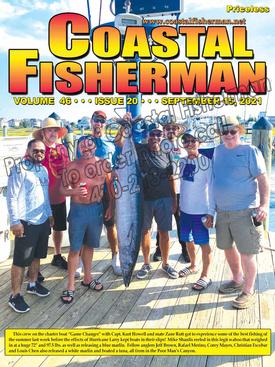


Article by Capt. Steve Katz
 The last few articles have reviewed first aid, insurance, and fires, unfortunately these topics became more relevant with recent trouble on the water in our area, our thoughts and prayers go out to all.
The last few articles have reviewed first aid, insurance, and fires, unfortunately these topics became more relevant with recent trouble on the water in our area, our thoughts and prayers go out to all.
In keeping with recent topics, this week’s article will review fire detection and protection systems on-board boats. Fire was ranked 5th on the Geico/Boat US insurance company causes for boat loss claims (2015-2019). When it comes to fire safety aboard boats, there are four areas of focus to protect life and property:
Prevention • Detection
Egress • Suppression
Two years ago the 120-foot Azimut private yacht “Andiamo” burned and sank in a Miami marina – the cause? A candle lit by the crew to illuminate the guest’s cabin during an lighting outage on board the yacht. Two small candles caused $6.3 million loss to the vessel and $480.000 in damage to the Miami marina and adjacent vessels. The National Transportation Safety Board (NTSB) who just concluded its findings, also found that the on-board fire detection and alarm system was not working properly which was known to be inoperable by the crew.
As a result of the fire, the Marshall Islands (the registry of the yacht) issued a yacht safety advisory on April 20, 2020, based on its investigations of four registered yacht fires during the previous year. The advisory highlighted three major areas of concern: preventing fires; ensuring fire-detection and extinguishing systems are fully functional; and ensuring yacht crews are prepared to respond to a fire. These areas of concern are applicable to all boat owners, without regard to the size of the boat.
Fire Detection &
Extinguishing Systems
Each boat is unique in its configuration, layout, use and accommodations, therefore fire detection and suppression systems need to be custom tailored to each boat. In addition to the original manufacturer of the boat, often a local fire prevention company or equipment manufacturer can advise on how best to equip your boat properly for fire detection and extinguishing systems.
Boat builders adhere to many codes, regulations and standards when designing and building a boat. When it comes to pre-installed fire detection systems, it seems that there is a wide variety of adherence to numerous and complex standards. The code of Federal Regulations (CFR) chapter 46 contains standards that require smoke detectors be installed in the sleeping compartment of small, inspected vessels. The International Standard Organization (ISO) standard 9094 is a standard for fire detection and suppression system boats that can be useful to boat builders and owners and requires detection systems in all habitable spaces. The American Boat and Yacht council (ABYC) has a standard A-4 that addresses firefighting equipment on pleasure craft.
The USCG and National Fire Protection Association standards reference the (Underwriters Laboratory) UL217 as the standard for smoke detection equipment. Though the UL standard UL217 is not specifically geared towards boats, it is still a good idea to be sure your smoke alarm equipment meets the UL217 standard.
Detection
If you are starting from scratch with no detection or prevention system or upgrading your systems, there are a few companies that specialize in fire detection systems for boats, such as Aqualarm, Fireboy and Sea-Fire. While not specifically designed for boats, a residential system such as the First Alert Onelink could be used on a boat as a DIY detection system. The Onelink system is a wirelessly interconnected system, so that if one sensor is triggered, all other sensors alert to that problem and even indicate the “zone” of the alert. Be sure that a detection system is present in every sleeping quarter of a boat, and of course machinery spaces. Be sure any system you install or have installed meets the requirements of your flag state, local jurisdictions and of course your insurance company.
Fire Suppression
Most boaters think of fire suppression as the fire extinguishers that the USCG “makes” you have on board. Often boaters never mount these or store these in an area that is accessible when there is a need to use them. The USCG standards are the minimum recommendations, it is a good idea to exceed the basic requirements and be sure that handheld fire extinguishers on your boat are of adequate size and type and are located in an area where they can be readily accessible and used effectively.
Larger boats often have a fixed fire suppression system located in the engine room, this system is often both automatic and manual – it is automatically deployed when the system's temperature sensor reaches a certain high point (175° F) or when activated manually by the crew.
Additionally, these systems in the machinery spaces should be interconnected with the engine(s) and other machinery in that compartment to shut off the machinery during a discharge event, preventing the extinguishing agent from being wastefully removed from the space by the air intakes from engines, generators fans etc. before the extinguishing agent can extinguish the fire.
In 2016 new USCG regulations took effect where the USCG changed their approval system for portable fire extinguishers, the USCG now includes by reference the UL performance-based classification system for portable fire extinguishers and the USCG has also adopted the NFPA 10 standard for the inspection of fire extinguishers while eliminating the USCG developed rating system for portable fire extinguishers.
While most fire extinguishers installed before 2016 had both the USCG and UL ratings, they are allowed to remain on board as long as they are still in good working order and of the size and type for the application.
When it comes to safety and the possibility of a fire on-board a boat, review and find solutions on your boat for the following four areas, they are critical in protecting life and property:
Prevention
Detection
Egress
Suppression